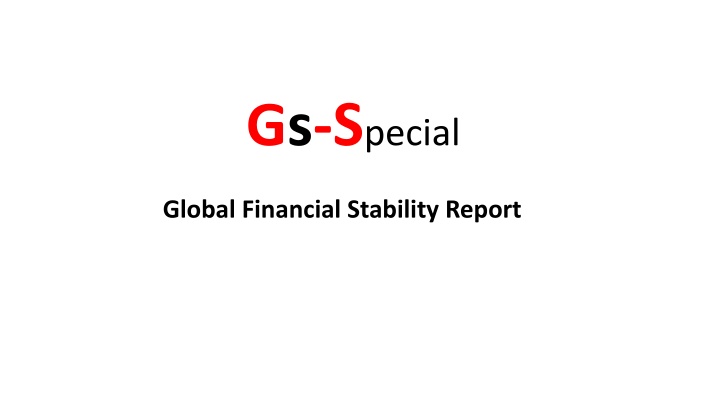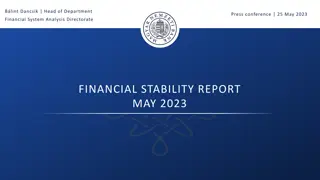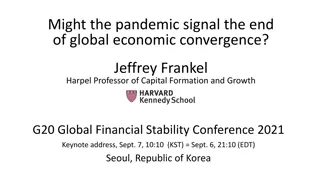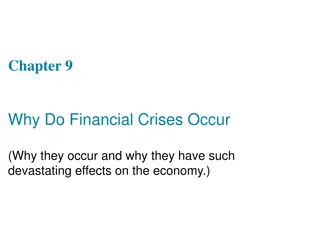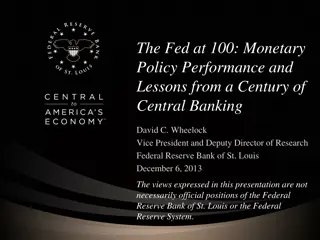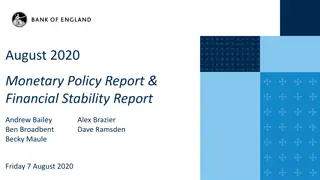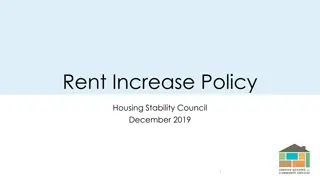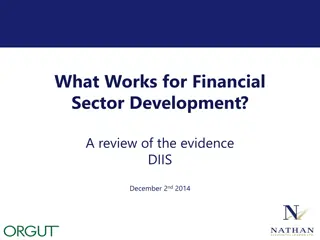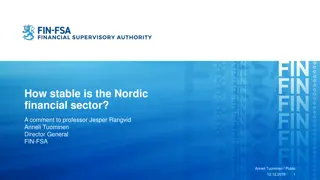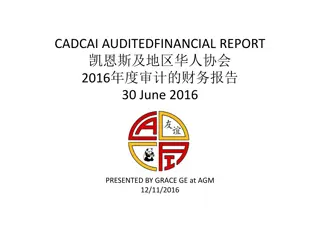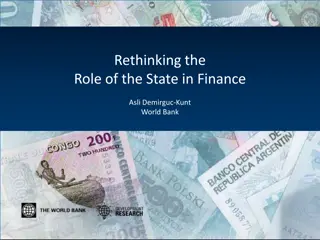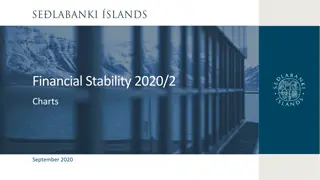Global Financial Stability Report Overview
The Global Financial Stability Report by the International Monetary Fund provides insights into the global financial system, emerging market financing, major indicators, and the concept of financial stability amidst events like COVID-19. It highlights key aspects such as market conditions, systemic risks, and the role of financial institutions in supporting economic activities. The report focuses on factors influencing financial stability and the implications for economic growth and sustainability.
Download Presentation

Please find below an Image/Link to download the presentation.
The content on the website is provided AS IS for your information and personal use only. It may not be sold, licensed, or shared on other websites without obtaining consent from the author.If you encounter any issues during the download, it is possible that the publisher has removed the file from their server.
You are allowed to download the files provided on this website for personal or commercial use, subject to the condition that they are used lawfully. All files are the property of their respective owners.
The content on the website is provided AS IS for your information and personal use only. It may not be sold, licensed, or shared on other websites without obtaining consent from the author.
E N D
Presentation Transcript
Gs-Special Global Financial Stability Report
Global Financial Stability Report International Monetary Fund (IMF) releases this report It is released Semi-annually Spring (April) and Fall (October) Overview: 1. The Global Financial Stability Report provides an assessment of the global financial system and markets, and addresses emerging market financing in a global context. It focuses on current market conditions, highlighting systemic issues that could pose a risk to financial stability and sustained market access by emerging market borrowers. The Report draws out the financial ramifications of economic imbalances highlighted by the IMF's World Economic Outlook. It contains, as special features, analytical chapters or essays on structural or systemic issues relevant to international financial stability. 2. 3.
Major Indicators 1.Global Financial Stability 2.Emerging and frontier markets 3.Corporate funding 4.Bank capital 5.Corporate sustainability
What is financial stability? acc to THE FED It isn't about preventing failure or stopping people or businesses from making or losing money. It is just helping to create conditions where the system keeps working effectively even with such events. A financial system is considered stable when financial institutions--banks, savings and loans, and other financial product and service providers--and financial markets are able to provide households, communities, and businesses with the resources, services, and products they need to invest, grow, and participate in a well-functioning economy. businesses need to borrow money to expand, build factories, hire new workers, and make payroll. All these things require a functioning financial system that works best when most people don't even think about it very much. Consumers and businesses just know that they can finance large expenses like the construction of a factory, or that their savings are safe, or that they'll be able to get short-term loans to make payroll.
What is Focus of 2021 Report? A. Covid-19 B. Crypto-currency transactions C. Climate change
Covid-19 Risk (A) Global: COVID-19 Financial conditions in advanced economies have eased further, on net, since the April 2021 Global Financial Stability Report, buoyed by expectations that monetary policy will remain accommodative. Financial conditions in emerging and frontier market economies are little changed, but the rapid spread of virus mutations and uneven access to vaccines pose a threat to the economic recovery. Credit conditions have improved in the corporate sector, albeit unevenly. Corporate balance sheets have generally strengthened, and profitability has improved. Advanced Economies: Central bank balance sheets in advanced economies have grown considerably during the COVID-19 pandemic in an effort to ease financial conditions and maintain the flow of credit to households and firms. Monetary authorities have increased the assets held on their balance sheets to close to 60 percent of GDP, almost double the level prevailing before the pandemic.
Crypto-Currency Transactions In India: India has seen a massive spurt in crypto users of late. The number of blockchain start-ups surpassed 300 in 2021, with the daily crypto trading volume peaking between $300 -$500 million. Global Consumer Survey in 2020: As per the survey, 99 per cent of its respondents responded that they did trade in crypto currencies. India ranks higher than China, United States, Germany and Japan in crypto adoption. Nigeria, Vietnam and Philippines topped the mentioned survey. Challenges: Challenges posed by the crypto ecosystem include operational and financial integrity risks from crypto asset providers, investor protection risks for crypto-assets and Defi, and inadequate reserves and disclosure for some stable coins. Cryptoization: IMF in its GFSR 2021 pointed out that for emerging market and developing economies, adoption of cryptocurrency might be luring but they also come with a set of potential macro-financial risks, especially with respect to asset and currency substitution. IMF referred to this phenomenon as 'cryptoization'. Bitcoin: It remains the dominant Crypto asset. However, its market share fell sharply in 2021 from 70 per cent to less than 45 per cent. Popularity of crypto-ecosystem: The crypto-ecosystem is free of intermediaries and match credit platforms match borrowers and lenders without any credit-risk evaluation. They operate directly on blockchains without any customer identification requirements. Asper the report, IMF said the deregulated finance made possible by the crypto ecosystem has particularly helped its popularity and intake.
Why Cryptos are vulnerable? Operational Risks: Operational risks may potentially result in significant downtime when failures and disruptions would prevent the use of services. High periods of transaction activity and poorly designed systems and controls make it particularly vulnerable to such risks. Cyber risks: Cyber risks occur because such systems are prone to cyber-attacks. Asset and currency substitution: It will be a major problem for emerging economies. Huge price volatility: Price fluctuation is extremely high but so is the return on such investments. This could potentially lead to huge losses for the customers. Governance Risks: These platforms lack transparency pertaining to how cryptos are issued and distributed. This could again pave the way for huge losses. Lacking oversight mechanism: Lacking an oversight mechanism, the ecosystem is vulnerable to consumer fraud and market integrity risk. No monitoring mechanism: The IMF stated that there is no reliable method to estimate the stock or flow of crypto assets based on country residency. It added that a commonly used proxy is residency estimates based on internet visits to websites of crypto asset providers.
Climate Change Climate: Fostering the transition to a green economy Total assets under management of sustainable investment funds are small but growing rapidly, more than doubling over the past four years to reach $3.6 trillion in 2020. However, climate-oriented funds accounted for only $130 billion of that total. Flows into sustainable funds appear to support climate stewardship and encourage the issuance of securities by firms with a more favorable sustainability rating. Sustainable investors could also bring financial stability benefits as they are less sensitive to short-term returns. Way Ahead There is a need to enact de-dollarization policies including- enhancing monetary policy credibility; a sound fiscal position; effective legal and regulatory measures; and the implementation of central bank digital currencies.
Financial Stability Report (FSR) by RBI, 2022 The global economic recovery has been losing momentum in the second half of 2021 in the face of resurfacing COVID-19 infections, supply disruptions and bottlenecks, elevated inflationary levels and shifts in monetary policy stances and actions across advanced economies and emerging market economies. On the domestic front, progress in vaccination has enabled the recovery to regain traction after the debilitating second wave of the pandemic, notwithstanding signs of slowing pace more recently; the corporate sector is gaining strength and bank credit growth is improving. The capital to risk-weighted assets ratio (CRAR) of scheduled commercial banks (SCBs) rose to a new peak of 16.6 per cent and their provisioning coverage ratio (PCR) stood at 68.1 per cent in September 2021. Macro stress tests for credit risk indicate that the gross non-performing asset (GNPA) ratio of SCBs may increase from 6.9 per cent in September 2021 to 8.1 per cent by September 2022 under the baseline scenario and to 9.5 per cent under a severe stress scenario. SCBs would, however, have sufficient capital, both at the aggregate and individual levels, even under stress conditions. Emerging signs of stress in micro, small and medium enterprises (MSME) as also in the micro finance segment call for close monitoring of these portfolios going forward.
